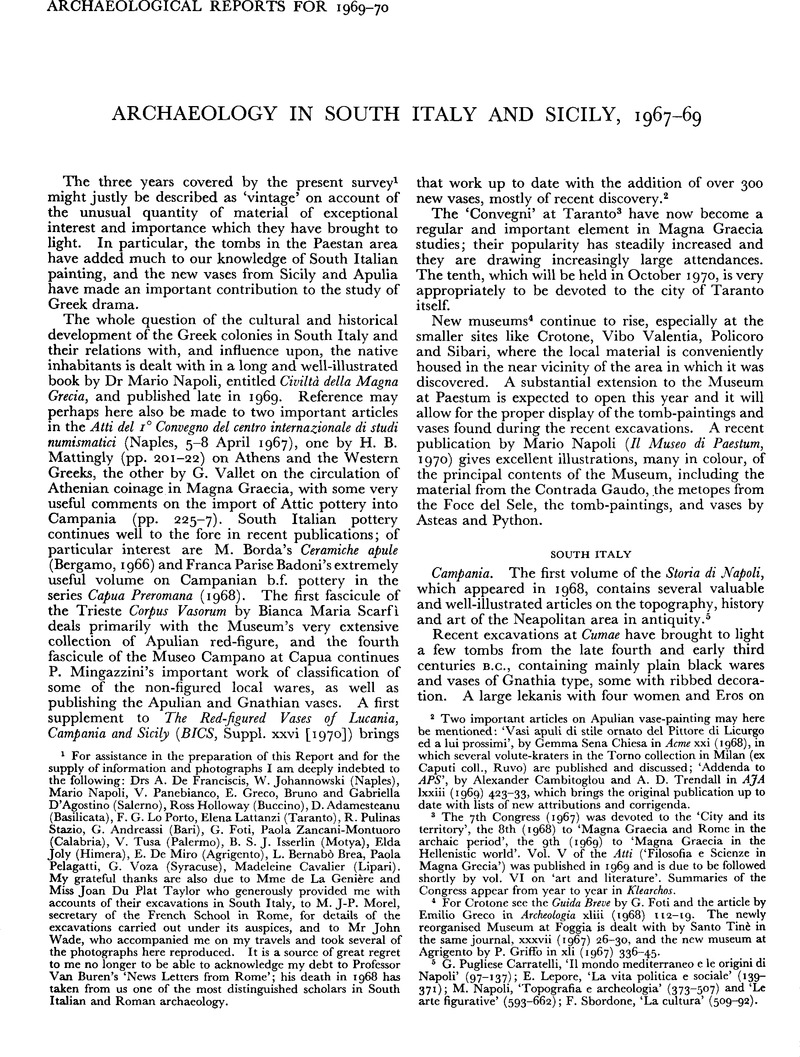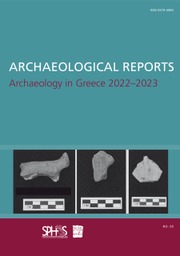Article contents
Archaeology in South Italy and Sicily, 1967–69
Published online by Cambridge University Press: 03 October 2012
Abstract

- Type
- Brief Report
- Information
- Copyright
- Copyright © Authors, the Society for the Promotion of Hellenic Studies and the British School at Athens 1970
References
1 For assistance in the preparation of this Report and for the supply of information and photographs I am deeply indebted to the following: Drs A. De Franciscis, W. Johannowski (Naples), Mario Napoli, V. Panebianco, E. Greco, Bruno and Gabriella D'Agostino (Salerno), Ross Holloway (Buccino), D. Adamesteanu (Basilicata), F. G. Lo Porto, Elena Lattanzi (Taranto), R. Pulinas Stazio, G. Andreassi (Bari), G. Foti, Paola Zancani-Montuoro (Calabria), V. Tusa (Palermo), B. S. J. Isserlin (Motya), Elda Joly (Himera), E. De Miro (Agrigento), L. Bernabò Brea, Paola Pelagatti, G. Voza (Syracuse), Madeleine Cavalier (Lipari). My grateful thanks are also due to Mme de La Genière and Miss Joan Du Plat Taylor who generously provided me with accounts of their excavations in South Italy, to M. J-P. Morel, secretary of the French School in Rome, for details of the excavations carried out under its auspices, and to Mr John Wade, who accompanied me on my travels and took several of the photographs here reproduced. It is a source of great regret to me no longer to be able to acknowledge my debt to Professor Van Buren's ‘News Letters from Rome’ his death in 1968 has taken from us one of the most distinguished scholars in South Italian and Roman archaeology.
2 Two important articles on Apulian vase-painting may here be mentioned: ‘Vasi apuli di stile ornato del Pittore di Licurgo ed a lui prossimi’, by Chiesa, Gemma Sena in Acme xxi (1968)Google Scholar, in which several volute-kraters in the Torno collection in Milan (ex Caputi coll., Ruvo) are published and discussed; ‘Addenda to APS’, by Cambitoglou, Alexander and Trendall, A. D. in AJA lxxiii (1969) 423–33CrossRefGoogle Scholar, which brings the original publication up to date with lists of new attributions and corrigenda.
3 The 7th Congress (1967) was devoted to the ‘City and its territory’, the 8th (1968) to ‘Magna Graecia and Rome in the archaic period’, the 9th (1969) to ‘Magna Graecia in the Hellenistic world’. Vol. V of the Atti (‘Filosofia e Scienze in Magna Grecia’) was published in 1969 and is due to be followed shortly by vol. VI on ‘art and literature’. Summaries of the Congress appear from year to year in Klearchos.
4 For Crotone see the Guida Breve by G. Foti and the article by Greco, Emilio in Archeologia xliii (1968) 112–19.Google Scholar The newly reorganised Museum at Foggia is dealt with by Santo Tinè in the same journal, xxxvii (1967) 26–30, and the new museum at Agrigento by P. Griffo in xli (1967) 336–45.
5 Pugliese Carratelli, G., ‘Il mondo mediterraneo e le origini di Napoli’ (97–137)Google Scholar; Lepore, E., ‘La vita politica e sociale’ (139–371)Google Scholar; Napoli, M., ‘Topografia e archeologia’ (373–507)Google Scholarand ‘Le arte figurative’ (593–662); Sbordone, F., ‘La cultura’ (509–92).Google Scholar
6 LCS Suppl. I, p. 59, nos. 826c, 835a, 845a
7 A preliminary publication of a few paintings will be found in Panorama, 31 October 196g, 69–71 and Time, 26 January 1970, 34. The illustration of the diver used here is taken from The Unesco Courier April 1970, p. 5, where some of the other paintings are also published.
8 AR 1966–67 31–2; NSc 1968, 197–204; LCS Suppl. I, pp. 92–3.
8a AJÀ lxxiv (1970) 145–8.
9 See Adamesteanu, , BdA lii (1967) 44–50Google Scholar and, for Metaponto, Porto, Lo, NSc 1966, 136–231.Google Scholar
10 See AR 1963–64 35–6; BdA 1 (1965) 5–37; LCS 50–9; Arch. Forschungen in Lukanien. II. Herakleia-Studien (RM, suppl. vol. 11, 1967) 198–231. A detailed survey of the area appears in Quilici, L., Forma Italiae, Regio III, I-Siris-Heraclea (Rome, 1967)Google Scholar and shorter accounts in Neutsch, B., Siris ed Heraclea (Urbino, 1968)Google Scholar and Adamesteanu, D., Siris-Heraclea (1969).Google Scholar There are two articles on the excavations by Neutsch, B. in ILN for 2 and 16 September 1967.Google Scholar
11 Bari antica (Studi di archeologia e d'arte in terra di Bari, I, 1966).
12 Brindisi e il suo Museo (Montesud Petrochimica, 1967); also in an English version (The Archaeological Museum of Brindisi), with a translation by David Nutt.
13 AR 1966–67 37; BSR xxxiv (1966) 134–50.
14 Herdonia (Brussels, 1969), with articles by L. Van Impe (historical survey), J. Mertens (topography and archaeology), R. Iker (local pottery), C. Delplace (lamps).
15 A preliminary account of this important find is given in a pamphlet prepared by Foggia Museum for the 12th Museum Week (1969).
16 Die lokrischen Tonreliefs (von Zabern, Mainz, 1968).
17 Reggio greca e romana (Edizioni Romeo, 1969; pp. 24, lire 1000).
20 Klearchos xxxv–xxxvi (1967) 192, fig. 3; Ann. Ist. Ital. Num. xii–xiv (1965–7) 21–30, pl. 18, I.
21 Klearchos xxxv–xxxvi (1967) 131–43.
22 McDevitt, A., Giotta xlv (1967) 161–3 and xlvi (1968) 254–6.Google Scholar
23 Roger Edwards, G., ‘Torre Mordillo 1967’ in Expedition vol. xi no. 2 (Winter 1969) 30–5.Google Scholar
24 See in particular the articles by P. Orlandini on the Museo Archeologico in Caltanissetta (no. 2, pp. 17–24), by Anna Maria Bisi on Lilibeo (no. 2, pp. 29–45),and by V. Tusa on Segesta (no. 6, pp. 5–10) and Selinunte (no. 7, pp. 5–18).
25 Syracuse, Collection Latomus lxxxvii (Brussels, 1967).
26 Syrakus (Gymnasium, Beiheft vi, Heidelberg, 1969).
27 inv. 66557; LCS Suppl. I, p. 105, no. 98a.
28 AR 1963–4 45; LCS 601, no. 98, pl. 235, 2–3.
29 ‘Una pisside del Museo di Ragusa’, in Cron. Arch e Storia dell'Arte v (1966) 72–6; see also LCS Suppl. I, p. 3g, no. 102a and pl. VIII, 2.
30 AR 1966–7 44; AJA lxx (1966) pl. 85, fig. 8; BdA li (1966) 95, fig. 22. See also Pelagatti, P., ‘Scavi e ricerche archeologiche nella provincia di Ragusa’, in Archivio Storico Siracusano xii (1966) 5–29Google Scholar , and ‘Appunti inediti su Camarina’, ibid. 120–44.
31 Pelagatti, , ‘Antefisse sileniche siceliote’, in Cron. Arch. e Storia dell'Arte iv (1965) 79–98.Google Scholar
32 Orlandini, , Arch. Cl. vi (1954) 251 ff.Google Scholar
33 BdA Hi (1967) 33–7.
34 LCS Suppl. I, p. 40, nos. 81a–81b.
35 Trendall, , Phlyax Vases2 no. (xii), pl. XIVcGoogle Scholar ; ibid. p. 52, no. 80 (where bibliography, to which the coloured reproduction in La Grèce Classique fig. 371 should now be added).
36 Meligunis-Lipara ii, pls 80–5. See also LCS Suppl. I, p. 102.
37 Palladio xvii (1967) 164–8.
38 See in particular Griffo, P., Sulla collocazione dei telamoni (Agrigento, 1952)Google Scholar , ‘Recenti ipotesi ricostruttive del tempio di Giove Olimpico’, in Atti VII° Congr. di Storia dell'Architettura (1955); Guide to the Monuments and Excavations (1956) 88 ff.
39 Griffo, , Guida3 p. 198.Google Scholar
40 Kokalos xiii (1967) 180–5.
41 Kokalos xii (1966) 8–35, and xiii (1967) 177–9; see also Orlandini's article ‘Gela—topografia dei santuari e documentazione archeologica dei culti’, in Riv. 1st. Arch, xv (1968) 20–66.
42 Himera—Campagne di scavo 1963–5 (Palermo, 1970).
43 See LCS Suppl. I, pp. 32, 34–6; associated vases include the bellkrater Sydney 46.45, the calyx-krater formerly in the Hirsch coll. (no. 775; Ars Antiqua, Sale Cat., 2 May 1959, pl. 61, no. 131), and now in the possession of Mr Arthur Silver in Santa Barbara (Calif.), and a calyx-krater in Nostell Priory with Marsyas and Olympos.
44 Tusa, Sicilia Archeologica no. 6 (June 1969) 4–10; Kokalos iii (1957) 85–8.
45 Galinsky, G. K., Aeneas, Sicily and Rome (Princeton, 1969) 81 ff., figs. 68–79.Google Scholar
46 In 1968 the excavation was supported by the Fairleigh Dickinson University (New Jersey) and conducted in association with the Department of Semitic Studies in the University of Sydney. Grants were made by the Russell Trust, the Leeds Philosophical and Literary Society and the S. H. Burton Trust. A preliminary publication appears in ILN 18 October 1969, 26–7.
47 Mozia v, 12–13, pl. 6; the skyphos is not South Italian, but Attic of a type common in the second quarter of the fourth century (F. B. Group; cf. ARV2 1490 ff.). For examples from Spain and Portugal see de Arribas, Gloria Trias, Ceramicas griegas de la peninsula iberica, pls. 242, 266–7.Google Scholar
- 1
- Cited by


